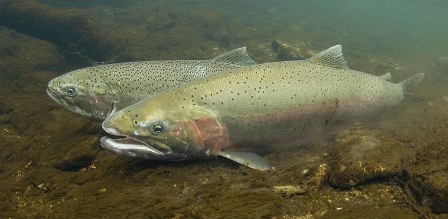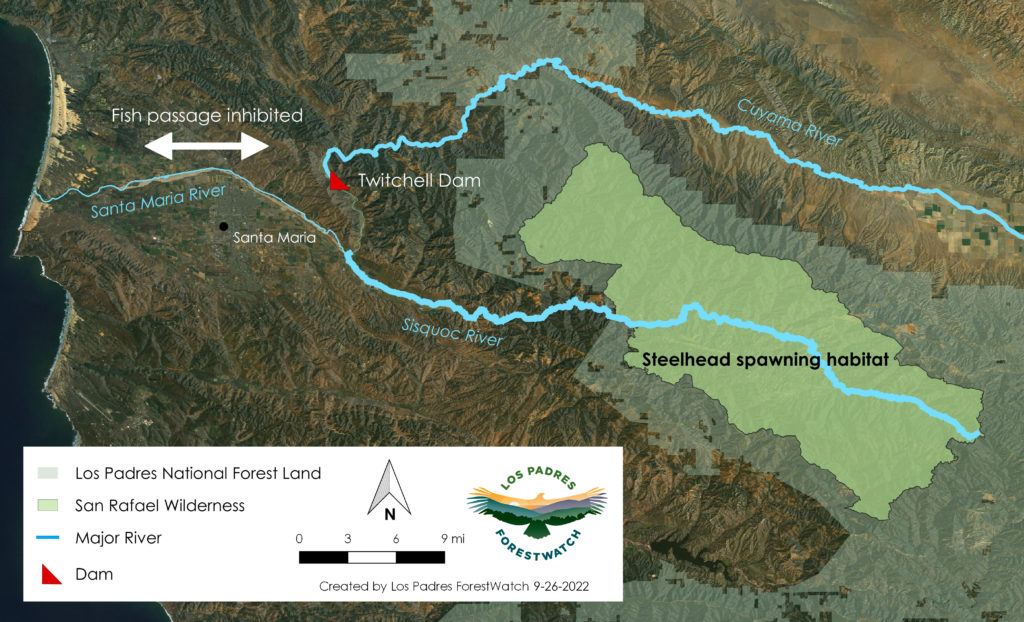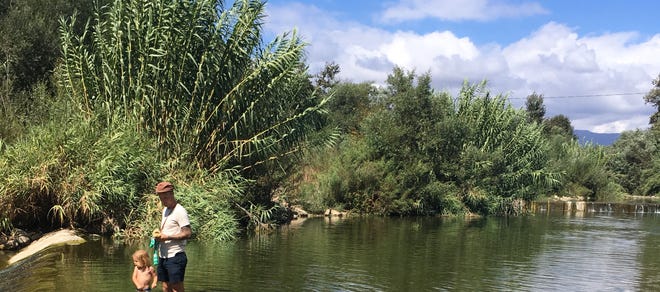ForestWatch and Partners Win Landmark Ruling to Protect Endangered Steelhead
by ForestWatch on SEPTEMBER 27, 2022 in CUYAMA VALLEY, RIVERS, SAN LUIS OBISPO COUNTY, SANTA BARBARA COUNTY
SANTA MARIA, CA – The Ninth Circuit Court of Appeals issued an opinion Friday ruling that the operators of Twitchell Dam – the Bureau of Reclamation (“Reclamation”) and the Santa Maria Valley Water Conservation District (“the District”) – can release water from the Dam to comply with the Endangered Species Act (“ESA”). This ruling marks an important step toward protecting the endangered Southern California Steelhead in the Santa Maria River system.

In 2019, plaintiffs San Luis Obispo Coastkeeper and Los Padres ForestWatch filed a lawsuit in federal district court, represented by the Environmental Defense Center, Sycamore Law, Inc., and Aqua Terra Aeris Law Group. The case alleges that the Dam’s operators are violating the ESA by limiting the quantity and timing of flows in the Santa Maria River to levels that harm the critically-imperiled Steelhead population. The case seeks to enhance an important stretch of the Santa Maria River to benefit the watershed, wildlife, and local communities. With adequate flows at the right times, Steelhead will be able to once again reach historic spawning grounds in the Sisquoc River, deep in the San Rafael Wilderness of Los Padres National Forest.
The Bureau and District claimed that they were prohibited from releasing water for fish based on the 1954 legislation that authorized construction of the Dam. Although the district court ruled for the Dam operators, plaintiffs appealed that ruling, and Friday’s ruling officially reversed the district court. The Ninth Circuit noted that the “current operation of Twitchell Dam harms Southern California Steelhead by impairing their ability to migrate and reproduce.” The Court went on to hold that operation of the Dam must comply with both the law authorizing the Dam and the ESA. As the Court ruled, “the Agencies have discretion to operate Twitchell Dam for other purposes besides irrigation, conservation, and flood control—including, potentially, adjusting water discharges to support the migration and reproduction of Southern California Steelhead.”
Twitchell Dam was constructed in the 1950s, and is located on the Cuyama River, the northern tributary to the Santa Maria River. The operation of Twitchell Dam limits the timing and quantity of flows in the mainstem of the Santa Maria River, preventing Steelhead from migrating to and from the ocean and upstream spawning habitat, as the following map depicts. Without adequate flows, fish are unable to complete this process and become stranded in the dry River system.

“Our lawsuit seeks to bring the Santa Maria Valley Water District out of the 1950s and into the 21st Century. Releasing water for fish migration will have virtually no impact on agricultural or domestic supply—our experts estimate 4% of reservoir water would be affected. Santa Maria can have both steelhead and its water supply with straightforward changes to water management,” said SLO Coastkeeper Executive Director Gordon Hensley.
“Endangered Steelhead have nearly disappeared from river systems throughout California’s central coast,” said Los Padres ForestWatch Executive Director Jeff Kuyper. “This landmark ruling finally gives us an opportunity to restore one of our region’s most prolific fisheries while maintaining reliable water supplies for our farms and communities.”
“This decision from the Ninth Circuit Court of Appeals is a critical first step toward recovering Steelhead—one of the most endangered fish species in the United States. The ruling puts an end to the Twitchell Dam operators’ arguments that their hands are tied and that they can avoid compliance with the Endangered Species Act,” said Linda Krop, Chief Counsel for the Environmental Defense Center, which represents Los Padres ForestWatch.

Seventy years ago, the Santa Maria River had the second largest Steelhead run in Santa Barbara County. By some estimates as many as 10,000 fish traveled up the watershed in wet years, with the Sisquoc River in the Los Padres National Forest being the most important spawning tributary within the stream network. However, several large dams have since blocked historic Steelhead runs. Now, Southern California Steelhead are one of the most endangered fish species in the United States. Steelhead are a keystone species for our region and an indicator of the health of our local waterways.
In 2007, the California Coastkeeper Alliance sued to compel the (then) California Department of Fish and Game to initiate stream flow studies as required by law. The resulting study by Stillwater Sciences recommended an improved flow regime at Twitchell Dam, yet the Water District and Reclamation refused to implement the recommendations. This lawsuit aims to implement the Stillwater Study’s recommendations to improve the flow regimes at Twitchell Dam and prevent continued harm to endangered Steelhead. The amount of water necessary to provide flows of appropriate timing and magnitude for Steelhead would constitute only roughly 4% of the reservoir’s average annual amount of stored water. No water would be released in extremely dry years.
This lawsuit complements a separate legal action filed by the two organizations in 2017. That suit, which is pending in state court, is based on longstanding California law that requires dam operators to provide adequate streamflow to sustain healthy fish populations.
Researchers launch expedition seeking ‘black box’ to salmon survival
By Kirk Siegler (NPR) Published January 31, 2022 at 3:00 PM CST

With some populations of Northwest salmon in peril, a team of scientists will launch an international expedition Tuesday into the remote Pacific Ocean, where they hope to find clues to the fish’s survival.
“Conditions are rough, you’ve got lots of really big storms,” says salmon biologist Laurie Weitkamp, one of the scientists leading the journey backed by the National Oceanic and Atmospheric Administration.
After the planned launch from Port Angeles, Wash., their 200-foot research vessel will spend a month trawling for salmon in the North Pacific, in waters that are notorious for high swells and dangerous winter storms.
“I’ve heard many people tell me I’m absolutely crazy to be out there,” she says.
Weitkamp is actually thrilled though. This is seen as a first of its kind expedition where four research vessels and sixty scientists from the US, Canada and Russia will cover a huge swath of the salmon’s ocean territory at once.
She and her colleagues at NOAA already know a lot about why the salmon aren’t making it to the ocean: think dams on the Columbia River and its tributaries, warming rivers, lower river flows. But they understand less about what’s going on out in the sea, which may be the most important part of the famed fish’s journey and key to its ultimate survival.
“Once salmon leave the coastal ocean, they effectively enter a black box,” Weitkamp says. “We don’t know where they are, we don’t know what they’re eating, what eats them, how quickly they’re growing.”
Or, why and where they’re dying. Weitkamp is most concerned about those recent “blobs” of warm Pacific Ocean water off the coast of Alaska.
“The purpose of this is really to dive in a bit more into this warming ocean and try and understand what’s going on,” she says.
The scientists hope to soon better predict what a year’s salmon run or catch will be for many who depend on them.
The economic and cultural stakes of an expeditions like this are high.
“The decline of salmon runs into our waters have been so detrimental to us,” says Shannon Wheeler, vice chairman of the Nez Perce Tribe in Idaho.
Wheeler says salmon runs have dropped from the millions a century or more ago to typically just a few thousand today, including the many raised in hatcheries. He says this alarming decline has had wide reaching effects on the environment as well as the tribe’s health and culture. The Nez Perce have disproportionately high rates of diabetes and other diseases.
“We can pinpoint that a lot of this wouldn’t be happening if we’d had the numbers of salmon we were promised,” Wheeler says.
Wheeler says the new research is potentially encouraging. But the Nez Perce are more focused on removing dams closer to home, so that the remaining healthy salmon Laurie Weitkamp is studying actually return in the fall, after the some 400 mile epic journey inland upstream to where they were born.
To see more, visit https://www.npr.org. Corrected: January 31, 2022 at 11:00 PM CST The audio of this story, as did a previous web version, says that salmon are on the brink of extinction in the Pacific Northwest. Some populations of the fish in the Northwest are indeed under threat of extinction and are listed as threatened or endangered under the federal Endangered Species Act, while other salmon species, including in Alaska, are considered healthy. And the audio, as did an earlier headline and earlier web version, incorrectly says the expedition will take place near the Bering Strait. It will take place in the North Pacific.
Copyright 2022 NPR.
News and videos about the urgent work being done to try and restore critical riparian habitat in our California waterways by the volunteers and professionals with CalTrout (www.caltrout.org) and their various partnering organizations.
Settlement agreement between environmental watchdog group Channel Keepers (SB) and the City of Ventura to provide enough water for the Steelhead trout in the Ventura River watershed!
Who gets Ventura River water? Ventura agrees to track, potentially reduce its usage
Arlene MartinezVentura
Editor’s note: This story has been updated with information about which agency will be studying health water flows for the steelhead population. It is the California Department of Fish and Wildlife.
To help protect endangered fish and other critters that rely on the Ventura River for habitat, migration and procreation, the city of Ventura has agreed to better monitor and reduce its water draw in dry times.
The city will also take steps to remove barriers for steelhead trout to make the journey to and from the sea, according to terms of a temporary settlement announced Monday.
The agreement reached between the city and the Santa Barbara Channelkeeper, which lasts 164 days and covers essentially Foster Park to the estuary, includes the following key elements:
- Flow monitoring. When the instream flow measures 4 cubic feet per second, the equivalent of just under 30 gallons, the city will shut off one of its three wells. Once it hits 3 cubic feet per second, the city will shut a second well and at 2 cubic feet per second, it will shut down all Foster Park facilities. If it’s after business hours, the change will take effect by 8 a.m. Pumping will be restored after 72 consecutive hours of flow above those thresholds.
- Fish barriers. The city will “take action” on two areas along the river at Foster Park that serve as potential barriers to fish passage during dry times. One is a 36-inch water line that comes up over the water surface during certain times of the year; the other is the top of a subsurface dam that again comes up over the water under certain conditions.
- An equipment check. The city will work to repair or install a new gauge at the Casitas Vista Road Bridge if the U.S. Geological Survey finds it working improperly.
- Attorney costs and fees. The city will pay Channelkeeper’s attorney $850,000 toward legal costs. That covers most, but not all, of the nonprofit’s bill.
The agreement comes in response to a lawsuit filed in 2014 by the Santa Barbara Channelkeeper, which wanted agencies responsible for tracking river usage to determine how much water was needed for the health of steelhead trout and others and how that worked with the demands of the city’s water customers.
More:Ventura’s awash in water litigation. This time, the target is state water
The city argued every user of the watershed should be included in that calculation and successfully sued to get them involved. That case continues. Meanwhile, the city and Channelkeeper entered into mediation earlier this year to figure out what alternatives existed that considered the needs of all users and dwellers.
The settlement represents the outcome of those talks, both sides said.
“We’re pleased to have secured a minimal amount of water for the river and for fish for the winter,” said Santa Barbara Channelkeeper Executive Director Kira Redmond. “It’s a big first step from where we were, and now we’re all sitting at the table and agreeing to the ground rules for what’s needed in the long term.”
It’s definitely a temporary solution, she said, but the arrangement will hopefully protect fish as a more permanent solution is developed.

Ventura Water spokesperson Craig Jones said a lot of work went into the terms of the settlement, and officials were happy about the outcome.
“We’re just in agreement to do this pilot to gather some more research to be able to better find a balance,” Jones said.
As to what it meant for water customers and the city’s supply in the long term, Jones couldn’t say. “But that’s why we’re looking at alternative water supplies for Ventura,” he said.
That includes getting a connection to state water and ramping up to build its biggest recycling facility to date in VenturaWaterPure, which will capture wastewater runoff, treat it, return it to the ground and then incorporate it into the city’s drinking supply. The latter project is a result of a previous settlement reached between environmental groups and the city over the wastewater treatment plant’s discharge into the Santa Clara River Estuary.
By year’s end, the California Department of Fish and Wildlife is expected to release a study analyzing what are healthy flows to sustain healthy steelhead populations. Then the state will take a closer look at the relationship between surface flow and groundwater flow and related factors before determining how much each water right holder can extract, Redmond said.
Arlene Martinez covers local government and energy. Reach her amartinez@vcstar.com or 805-437-0262. Follow her on Twitter @avmartinez.
IMPORTANT UPDATE
VENTURA RIVER WATERSHED ADJUDICATION PROCEEDING
(Kimberly Rivers, VC Reporter) -The action taken by the city of Ventura involving over 12,000 properties in the watershed is moving forward and is not directly impacted by the settlement between Channelkeeper and the city. The court scheduled the next Status Conference for 2 p.m. on Nov. 16 at Los Angeles County Superior Court, Complex Civil Litigation Division, Department No. 010, 312 North Spring St., Los Angeles. For information on making a telephonic appearance, please visit courtcall.com/?c=CCHOME, or call 888-882-6878. Los Angeles County Superior Court has granted the city’s request to push back the deadline for parties to file and join the action to Oct. 30. Property owners with questions or who wish to file to join the action can contact an attorney or visit the city’s information website at www.venturariverwatershedadjudication.com.
SUPPORTING OUR WORK
To support our ongoing efforts to bring you the finest in local environmental news reports, interviews & features, please click the button below & thank you for your support!